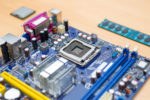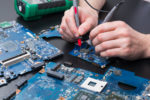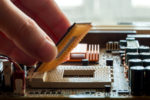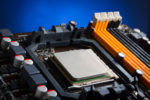Best Hackintosh Motherboard: Complete Reviews With Comparisons

The web is overflowing with resources that can help you build your first Hackintosh.
However, such resources might present a specific list of components attributable only to a single motherboard.
We’re here to provide you with an outline of the best Hackintosh motherboards to help you run a macOS on a PC.
We’ll also help you with the setup by recommending components that go well with these top-rated motherboards for a Hackintosh build.
These boards use Intel-based platforms, including some Z390 chipset motherboards.
Comparison Chart
Hackintosh Motherboard Reviews
1. Asus ROG Maximus XI Hero (WiFi)
The Asus ROG Maximus XI Hero (WiFi) is an ATX motherboard using the Z390 chipset.
It is the cheaper and toned-down version of the Maximus Xi Code and the Maximus XI Formula.
Like most Z390 motherboards from Asus, the Maximus XI Hero came out in 2018.
Review
With the Asus ROG Maximus XI Hero (WiFi), you can run a macOS Catalina 10.15.3 with a dual-boot Windows 10.
Some setups have successfully used the i9-9900k processor and an AMD Radeon VII graphics card.
You will also find sources citing High Sierra and Mojave builds using i7-9900k and an NVIDIA GTX 1070 GPU.
ALSO READ: Best LGA 1150 Motherboard
- Features
The ROG Maximus XI Hero works with 8th and 9th Gen Intel Core, Pentium Gold, and Celeron CPUs.
It allows up to four memory modules having a total RAM capacity of 128GB.
While its expansion sockets allow multi-graphics setups, you might have a hard time setting it up with more than one GPU while “Hackintoshing.”
The storage interface permits up to two M.2 connections and six SATA drive attachments.
- What Works
If you plan to use an NVIDIA graphics card, try setting this motherboard up with macOS High Sierra 10.13.6.
On the other hand, if you would like to upgrade to the more recent Catalina, you should try installing Mojave 10.14.6 first.
You will find that AMD graphics cards fare better during initial setup and installation, and some NVIDIA GPUs tend to result in more problems.
With this motherboard, essential features seem to work seamlessly, and you will find a lot of guides explaining how-tos and whatnot.
Functions such as USB charging and connectivity, Ethernet connectivity, Sleep, Wake, and iMessage are the easiest to get up and running smoothly.
- What Won’t Work
During an initial setup with High Sierra, you will find that audio works, but with some malfunctions, especially when waking up from sleep mode.
Other features that won’t initially work include wireless connectivity for both WiFi and Bluetooth.
You will also find some NVRAM issues with some macOS versions.
PROS
CONS
2. Asus ROG Strix Z390-I Gaming
If you want to build a small Hackintosh, the Asus ROG Z390-I Gaming is an excellent option.
It is a mini-ITX motherboard with the Z390 chipset, and it offers a comprehensive and well-balanced feature set for building a Hackintosh.
Review
For many Hackintosh builders, a small form factor motherboard can help minimize spending on extensive components that would otherwise be unusable.
The Strix Z390-I can run both Mojave and Catalina using the Clover Configurator, with an i5-9600k and an AMD Radeon Vega 56.
If you want to use OpenCore to set up your Hackintosh, you’ll be glad to know that the open-source configurator supports upgrades to Big Sur.
- Features
The Z390-I also supports both 8th and 9th Gen Intel Core processors, a vast list that could work well with a Hackintosh.
Since it is a mini-ITX board, it only has two memory slots and one expansion socket.
While the single expansion socket is enough for a compatible GPU, some might find the dual memory sockets inadequate for optimum memory clocking.
Asus also stripped down the storage connectors on this board to just four SATA ports and two M.2 slots.
This storage allowance should be enough for a Hackintosh intended for work and play.
However, it could be inadequate for users with loads of files and apps.
- What Works
Using th3e Clover Configurator, this motherboard can successfully run audio, display connectivity, and graphics for a Mojave or Catalina build.
Other functional essentials include power management, WiFi, Ethernet, USB mapping, AirDrop, and Instant Hotspot.
Furthermore, iMessage, FaceTime, and iCloud seem to work just fine.
- What Won’t Work
Initial observed problems include malfunctioning Bluetooth and inoperable GPU fans.
Additionally, some users of Hackintosh Z390-I computers have reported problems with Sleep and Wake.
PROS
CONS
3. Asus ROG Strix Z490-E Gaming
The Asus ROG Strix Z490-E Gaming is an ATX motherboard hailing from the mainstream lineup of the ROG Z490 family.
While the ROG Z490 family also carries better Maximus boards, their hefty price tags make shifting to a Hackintosh from a real Mac impractical.
Review
Since it carries the newer Z490 chipset, the Z490-E supports later processor models, graphics cards, memory modules, and storage drives.
It is also not as expensive as the Designare, Aorus Ultra, or the Maximus XI Hero.
Compared to older Z390 motherboards, the Z490-E can move forward with macOS upgrades for years to come.
The Z490-E offers smooth installations of macOS Big Sur 11.6, and it has better chances of easing into the recently released Monterey.
- Features
The Z490-E supports 10th Gen Intel Core processors, four DDR4 memory modules, three graphics cards, and eight storage devices.
Its maximum RAM capacity is 128GB, and it can overclock memory up to 4600MHz.
Since it has three full-sized expansion sockets, you can support a multi-GPU Windows and a single-GPU macOS using the same system.
You can also split your storage modules between the two operating systems.
- What Works
Successful pairings with this motherboard have used a 10900k CPU and a Radeon RX 560 GPU.
Even without the Radeon GPU, display monitors will function normally with the integrated graphics on the processor.
Everything works smoothly after an OpenCore installation of Big Sur 11.6 as long as you follow the exact instructions from successful builds.
- What Won’t Work
During the initial boot after macOS installation, noticeable issues include a malfunctioning Apple TV and USB connectivity.
Some tweakers have also reported problems with wireless and wired network connections, AirDrop, and UI scaling.
PROS
CONS
4. Gigabyte Z390 Aorus Ultra
If you’re having difficulty looking for enough sources for a Z490 Hackintosh, you might want to revert to another Z390 build.
In that case, you should also look at the Gigabyte Z390 Aorus Ultra.
It is an ATX motherboard coming from Gigabyte’s enthusiast-grade Aorus family.
Review
With the Z390 Aorus Ultra, you can work your way up, starting with a macOS Mojave and tweaking until you fine-tune a Big Sur.
When you upgrade to a Big Sur, you’ll probably have a vast knowledge base for creating a Hackintosh using a fresh macOS installation.
With this motherboard, you can access support from both Clover and OpenCore configurators.
An example of a successful Big Sur 11.0.1 build uses an i7-9700k processor and a Radeon RX 590 graphics card.
- Features
If you haven’t decided on a processor for this motherboard yet, you can choose from any of the 8th and 9th Gen Intel Core CPUs.
Also, choose your memory modules wisely, and decide whether to use all four DDR4 DIMM sockets for a maximum RAM capacity of 128GB.
Like most ATX alternatives, this motherboard features plenty of expansion sockets, enabling you to switch between Windows and Apple graphics apps.
Since this motherboard has the most storage interface connectors, it provides maximum storage flexibility for your macOS.
- What Works
After a fresh macOS install, a Radeon GPU and the wired network connector will function properly.
Other hardware and software components will run smoothly but may require different drivers than they currently have.
- What Won’t Work
During any update or fresh install, USB connectivity will typically malfunction.
You have to remap all your USB ports after every installation or macOS upgrade.
Also, the built-in wireless module will not work, and you need to replace it with compatible hardware if you need WiFi or Bluetooth.
RELATED: Best Budget Motherboard (Guide)
PROS
CONS
5. Gigabyte Z390 Designare
The Z390 Designare is another enthusiast-grade ATX motherboard intended for artists, designers, and content creators.
It boasts an extensive set of high-end features that can enable the seamless operation of many Apple-based creator software.
Review
The Z390 Designare is quite an expensive board, but we can cite multiple sources featuring it as an excellent Hackintosh motherboard.
As such, you can benefit from using it as your mainboard since finding compatible components is relatively easy.
Like the Z390 Aorus Ultra, the Z390 Designare is perfectly capable of running a Mojave, a Catalina, or a Big Sur.
- Features
CPU support, memory allowances, and expansion options on the Designare are similar to those on the Aorus Ultra.
The only notable difference in main components is its slightly fewer storage connectors.
However, the Designare boasts a plethora of connectivity features, especially on the rear panel.
Making these connectors functional for a Hackintosh is a challenge, but they will diversify the macOS if you get them all to work.
- What Works
The Designare can run a functional Hackintosh if you pair it with an i7-9700k and an AMD RX 580 graphics card.
Before setting it up with a Big Sur, you might want to start with a Mojave or at least a Catalina.
Doing so will help you understand all the required installers and driver updates for a smooth transition into Big Sur.
- What Won’t Work
Like the Aorus Ultra, features that won’t work after a macOS update or fresh install include malfunctioning USB ports and wireless connectivity.
While you can get the USB ports to work with some patches, you would need to replace the WiFi module.
PROS
CONS
What Is Hackintosh Used For?
“Hackintosh” is a portmanteau of the word “hacking” and the brand Macintosh.
It is a technique that employs typical desktop PC components to run Mac operating systems (OS) as if they were typical Mac computers.
In essence, building a Hackintosh means hacking, jailbreaking, or modifying a macOS to work on a PC designed for Windows.
Is Hackintosh Illegal?
“Hackintoshing” also means running a macOS on computer hardware not authorized by Apple.
Apple claims that it is illegal to build Hackintosh computers since such systems violate the Digital Millenium Copyright Act (DMCA).
Moreover, assembling a desktop PC that hacks macOS versions breaks Apple’s end-user license agreement (EULA).
Nevertheless, since Macintosh computers use Intel-based components, only a handful of limitations prevent a macOS from operating on Intel-based PCs.
The DMCA restrictions also only protect Apple’s interests in the US, and some changes to jailbreaking laws have placed “Hackintoshing” into a legal gray area.
Why Would You Want a Hackintosh?
People who have delved into “Hackintoshing” have found it beneficial for several reasons.
First and foremost, it is cheaper to build a Hackintosh than to purchase a Mac right out of any Apple Store.
Beginning in 2015, Apple solders every component together, making it physically impossible for partial upgrades.
A Hackintosh makes macOS repairs and piecemeal upgrades easier and faster, as long as you know what you are doing.
Finally, with a Hackintosh, you have the freedom to customize components, a capability that branded Apple products do not usually provide.
Apple only offers computers with a specific set of features that are untweakable without jailbreaking.
What Are the Downsides of Hackintosh?
Hackintosh computers are excellent alternatives to Mac computers, but remember that you are hacking your way into a macOS.
Since Apple did not intend any macOS for desktop PCs, there will always be some downsides as you build a Hackintosh.
One of these downsides is that you won’t get any support and after-sales services from Apple.
You have to know that you’re virtually on your own whenever you hack a macOS.
Furthermore, you are solely accountable for any problems that may arise.
Another disadvantage of a Hackintosh is some parts won’t work, plain and simple.
Finally, while we previously mentioned that upgrades are a possibility, there is always a chance that you’ll run into some issues.
With a Mac computer, you receive streamlined upgrades.
On the other hand, the process is almost always more tedious on a Hackintosh.
Fortunately for you, the Hackintosh community is a vast network of macOS tweakers.
You will always find a plethora of videos, guides, and forums that can provide answers to all your questions.
How Difficult Is It To Make a Hackintosh?
If this is your first Hackintosh build, there is a fat chance that you will have a hard time.
A Hackintosh is a whole new world regardless of your transition knowledge between a Mac and a PC.
The biggest dilemma you will face is that most online resources will speak out to you as if you already understand how Hackintosh computers work.
Another thing to consider is your choice of components.
Building a Hackintosh can be more challenging if you choose an AMD Ryzen system with an NVIDIA GPU.
Since many Mac computers nowadays use the same hardware as Intel-based PCs, your best approach to building a Hackintosh is by using Intel components.
To make things easy-peasy, you will need a DIY mindset, plenty of time and resources to spare, and a big bag of patience.
Do enough research before you start tinkering, and be ready for any problems that you may encounter.
So, Which Is the Best Motherboard for a Hackintosh?
If you haven’t noticed, our options are slightly older motherboards.
Since newer alternatives, including Z590 motherboards, have limited documentation on whether they work well for a Hackintosh, you’ll do better by sticking to our options.
Nevertheless, all of these motherboards are enthusiast-grade, and they are fully capable of competing against branded Apple products.
After some deliberation, we found the Asus ROG Strix Z490-E Gaming to be the top Hackintosh motherboard among the options.
Aside from having a newer chipset that supports better components, it can run Big Sur, the most recent efficiently workable macOS for a Hackintosh.
The newer macOS Monterey is out for the taking, but it is relatively new, and there are only a handful of resources on the matter.














